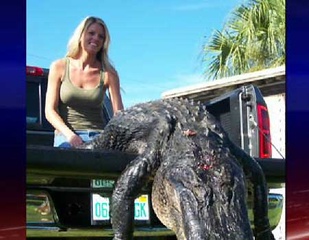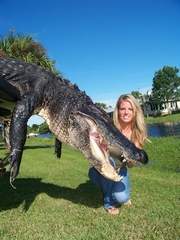
July 30, 2011

Due to my new posting yesterday about a Massachusetts “crazy croc,” an Australian commented on the Cryptomundo Facebook page a couple times, taking me to task for using “croc” regarding an alligator. As I tried to explain, alligators are crocodilians. Besides, it has become a shorthand Fortean and crypto way to talk about all of these out-of-place caimans, crocodiles, and alligators as “crazy crocs” for years.
Then he came back with this: “I always read ‘Crocs’ to mean ‘crocodiles’ or, at a pinch, ‘very ugly shoes’. If one has to abbreviate, why not ‘Gators’? Not lovely and alliterative, but less misleading.”
Actually, “crocs” is the least misleading term to use. Americans often “report” or “sight” an animal that they tell law enforcement officials are definitely “alligators,” but which turn out in reality to be a “cryptid” and sometimes do turn out to be caimans or crocodiles. Since alligators, caimans, crocodiles, and a few other species are indeed crocodilians, to call the initial accounts “crazy crocs” is more correct, in the long run.

Tensions always seem high in the media when the subject of “crazy crocs” comes up every spring for one major reason: people have been killed by them. Florida suffers fatal alligator attacks more frequently than one might suppose, so Floridians are on super alert.

The recent Trinity gator was from Texas. This is not to be confused with the “crazy crocs” and similar cryptids reported from the Trinities of California and British Columbia.
“Croc” sightings (from places as diverse as Tennessee and Austria) and findings (especially of things like “Maine Gators”) are of interest to cryptozoologists.
Why, you ask? Well, there are several reasons, including (please add your own, in comments):
1) some Lake Monsters are initially reported to look like alligators;
2) some water cryptids may turn out to be alligators or other pet croc escapees;
3) keeping track of the expanding or pet escapee enhanced alligator range is a good idea;
4) field-aware cryptozoologists like to know if there are any dangerous animals in the path of their pursuits;
5) out-of-place ‘gators are cool and very Fortean.
Of course, getting killed and eaten by a gator is not cool, but it might be Fortean.
About Loren Coleman
Loren Coleman is one of the world’s leading cryptozoologists, some say “the” leading living cryptozoologist. Certainly, he is acknowledged as the current living American researcher and writer who has most popularized cryptozoology in the late 20th and early 21st centuries.
Starting his fieldwork and investigations in 1960, after traveling and trekking extensively in pursuit of cryptozoological mysteries, Coleman began writing to share his experiences in 1969. An honorary member of Ivan T. Sanderson’s Society for the Investigation of the Unexplained in the 1970s, Coleman has been bestowed with similar honorary memberships of the North Idaho College Cryptozoology Club in 1983, and in subsequent years, that of the British Columbia Scientific Cryptozoology Club, CryptoSafari International, and other international organizations. He was also a Life Member and Benefactor of the International Society of Cryptozoology (now-defunct).
Loren Coleman’s daily blog, as a member of the Cryptomundo Team, served as an ongoing avenue of communication for the ever-growing body of cryptozoo news from 2005 through 2013. He returned as an infrequent contributor beginning Halloween week of 2015.
Coleman is the founder in 2003, and current director of the International Cryptozoology Museum in Portland, Maine.
Filed under Animal Escapees, Crazy Crocs, Cryptomundo Exclusive, CryptoZoo News, Cryptozoologists, Eyewitness Accounts, Giant Cryptid Reptiles, Lake Monsters